| |
 Game Description Game Description
Send the cast of Red Dwarf throughout the ship, outer space and the timestream itself in search of fun, love and an edible pot noodle. Score plot points by completing having the cast complete various missions. Try to keep your opponent from scoring by interfering with his plans.
 Card Types Card Types
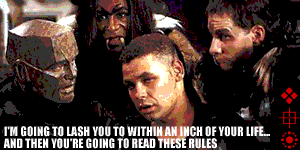 There are four types of cards in Red Dwarf: the Card Game. The current edition is version 2; look for the "v2" somewhere below the lower right of each card's artwork.
There are four types of cards in Red Dwarf: the Card Game. The current edition is version 2; look for the "v2" somewhere below the lower right of each card's artwork.
- Mission cards represent the duties and activities of the crew of the Jupiter Mining Corporation ship, Red Dwarf. Mission cards come in two different types: episode cards and task cards.
- Travel cards represent the places and objects that the crew use while carrying out a mission. Travel cards include ship locations like the Drive Room and Hallways, helpful items like Matter Transporters and Skutters. Holly is a special kind of travel card. Each travel card has it's own special icon.
- Re-Cyc cards allow for the element of surprise and game development. Re-Cyc cards let the players interact and allow the continual draw of new cards. Re-Cyc cards come in three varieties: Trouble, Bonus Points and Instant Effects. Instant effects come in three types: Focus, Distract and Smeg Off.
- The crew of Red Dwarf are represented on the four cast cards. Each cast card has a crew member on one side and a focused version of the same character on the other.
 Card Descriptions Card Descriptions
 |
Cast - The four cast cards (Lister, Rimmer, Cat and Kryten) have two sides: normal on the front of the card and focused on the back of the card. The focused side has the word "Focused" on it. Each cast member begins the game in his normal persona.
|
 |
Task - The cast member that can play the task is listed across the top (Lister, Rimmer, Cat, Kryten or Any). The name of the task is listed at the bottom of the card, along with its plot point value. The ribbon along the left indicates the exact types of travel cards needed to complete the task. These travel cards do not have to be played in this particular order. |
 |
Episode - The amount of cast members required to attempt the episode is indicated by the number after "episode:" at the top of the card. Episodes may be attempted by any combination of cast members, not just those depicted in the card's artwork. The name of the episode is listed at the top of the card, plot point value at bottom right. The ribbon along the left indicates the exact types of travel cards needed to complete the episode. These travel cards do not have to be played in this particular order. |
 |
Travel - Travel cards have their name listed across the top and bottom, and their identifying icon in the corners. |
 |
Re-Cyc: Trouble - The name of the card is above the text box. How to play the card is described inside the text box, and the travel card that the trouble card is played against is represented by the travel icon in the upper right corner. |
 |
Re-Cyc: Bonus Points - The name of the card is above the text box. How to play the card is described inside the text box, and the travel card that the bonus point is played along with is represented by the travel icon in the upper right corner. The amount of plot points the card is worth is shown at the lower left. |
 |
Re-Cyc: Instant Effects - The name of the card (Focus, Distract, Smeg Off) is listed above the text box. How to play the card is described in the text box. |
|
| |
 Set Up Set Up
Remove the following cards from the deck:
- the 4 cast cards
- the 16 episode cards
- Holly
Note that the rest of the cards all have a light white strip on the bottom (with the text Red Dwarf: The Card Game). Whenever you play, you always remove the cards without the white strip, and you always shuffle the cards with the white strip.
Place the cast in the center of the playing area. It does not matter what order the cast is placed. Each cast card has two sides: a picture of the cast member on one side and a picture of that character when he is focused on the other. At the beginning of play, all four cast cards should be placed with the focused side down, un-focused side up. It does not matter which player these cards are facing.
Place the 16 episode cards along one side of the playing area, easily accessible to both players. This area is called the BBC. Each episode represents a large-scale mission that any combination of cast can try to complete. The arrows across the top of the card indicate how many cast members are required to attempt the episode. Episodes come in three of these varieties: 2 cast, 3 cast and 4 cast. For sake of convenience, you can place episodes that are the same cast number together.
Place Holly near the episodes, in the BBC. Holly is a unique travel card that all players have equal access to at all times. (figure 1)
Shuffle all other cards and deal 7 cards to each player. Place the remaining cards as a draw pile, called the laundry list.
Choose one player to go first.
|
figure 1
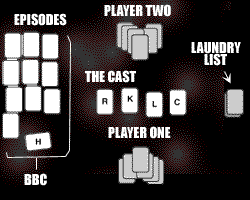 This is how the table should look to you, player one.
|
| |
 Playing Tasks and Travels Playing Tasks and Travels
Draw one card from the laundry list. You may play only one non-Re-Cyc card on your turn.
- If you choose to play a task card, you place the card under the appropriate cast member. That cast member is considering to be attempting to complete that particular task. You may only play task cards on your side of the playing field. Completing these missions is how your score plot points and win the game. (figure 2)
- If you choose to play a travel card, you place the card under the cast/mission card you are assigning it to. Travel cards do not have to be played in the order listed on the mission card. A travel card can only be played if its icon matches an icon on the mission. (See figure 8 for a chart of all the icons.) You may only play travel cards on your side of the playing field. You play travel cards in hopes of completing a mission; you may play travel cards to complete any mission played by any player. As soon as you play a travel card, your opponent has the opportunity to respond to this play. (figure 3)
The travel card "Junior Colour Encyclopedia of Space" is a wild card, and may be played to represent any travel card needed in the mission's chain of icons. However, your opponent may not respond to a played wild card with a seemingly appropriate discard travels card. The wild card, even after being played, may count as any needed travel card. For example, you may play the wild as a Drive Room, but then change it to a Hallway if you are later able to play a Drive Room.
Any player may also play episode cards and Holly as if these cards were in his hand. However, if Holly or an episode is already in play by another player, they cannot be removed and played again by the other player.
- If you choose to play an episode card, you place it under the proper amount of cast members. Cast members may be rearranged to suit the needs of the episode. You may only play episode cards on your side of the playing field. (figure 4)
- If you choose to play Holly, treat her exactly as a travel card. Remember, there is only one Holly, and you can only play one card per turn. So if you play a mission that includes Holly, be aware that your opponent's next move may be to play Holly on his side of the playing field. As soon as you play Holly, your opponent has the opportunity to respond to this play.
When you draw your card at the beginning of your turn, you are at 8 cards. If you cannot play any cards during your turn - or do not wish to play any cards - you must discard down to 7 cards to end your turn.
However, your turn is not considered to end until the moment that your opponent draws his card.
|
figure 2
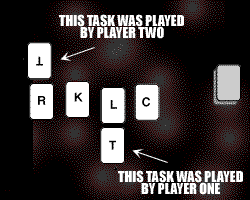 In this diagram, you have played a task (T) under Lister (L). Your opponent has played his own task card under Rimmer (R). Note that it never matters which way the cast themselves are looking; you could use action figures to represent the crew if you wanted.
figure 3
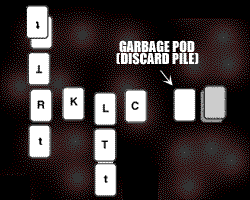 By this point in the game, you have played a travel card (t) under Lister's task and a second travel card under Rimmer's task. Just because your opponent 'owns' Rimmer's task doesn't mean you can't try to complete it first to score the points! Your opponent has also played two travel cards, both of them on Rimmer's task. Note that the garbage pod, or discard pile, is starting to take shape as well.
|
| |
 Playing Re-Cycs Playing Re-Cycs
Certain Re-Cyc cards may only be played at certain times. Be aware that every time you play a Re-Cyc card, you immediately draw a card from the laundry list. This way, you should always be at 7 cards (during your turn or opponent's turn) or 8 cards (during your turn only). Re-Cyc cards all have a green background... so when you play a green card, remember to draw from the deck!
- Bonus Points - You may only play a bonus point card when you play the appropriate travel card. Both cards are played simultaneously.
For example, you play a Hallway travel card on an appropriate mission along with the Bazookoids bonus point. Your opponent now has the opportunity to respond to this play. If the Hallway card is played successfully, the Bazookoids card is considered scored and placed in your stasis booth. If, for whatever reason, the Hallway cards and/or the Bazookoids card is countered by your opponent, the Hallway card is sent to Silicon Heaven, and the bonus point is placed in the garbage pod, on top of all other discarded cards.
Immediately after playing the bonus point, regardless of whether it was successful or not, draw a card from the laundry list.
- Trouble - You may only play a trouble (discard travels) card when your opponent plays the appropriate travel card.
For example, your opponent plays an On Planet travel card, and you respond with the trouble card Psirens (which targets On Planet cards). Your opponent now has his own opportunity to respond to your play. If the Psirens is played successfully, all of your opponent's travel cards for the mission on which the On Planet was played are sent to Silicon Heaven, including the On Planet. The Psirens is placed in the garbage pod, on top of the other discarded cards. If the Psirens was not successful, the On Planet card is played successfully and the Psirens is placed in the garbage pod. (figure 5)
Trouble cards cannot be played against the last card needed to complete the mission.
Immediately after playing the discard travels regardless of whether it was successful or not, draw a card from the laundry list.
-; The instant effect cards - Focus, Smeg Off and Distract - can be played at any time on your turn or your opponent's turn. Always remember to draw a card from the laundry list as soon as you play the instant effect card.
Playing Distract: Play the distract card on a certain un-focused cast member that is currently on a mission. Your opponent has a chance to respond to this action. If the distract is played successfully, the mission card and all travel cards on both sides are sent to Silicon Heaven. If the distracted cast member was attempting to complete an episode and was paired with focused cast member(s), flip the focused cards over to indicate that they are now un-focused. Place the distract card in the garbage pod on top of all other discarded cards.
The distract card is extremely nasty, since it can come at any time and it can wipe out a very thought-out strategy. To calm the effect of this card, you may wish to declare that a player may only be use the card on his or her own turn. If you still keep the regular ruling on distract, always try to keep a smeg off or two handy when you really get into a mission!
Immediately after playing the distract, regardless of whether it was successful or not, draw a card from the laundry list.
Playing Focus: To avoid cast from becoming distracted, play the focus card on them. A focused cast member cannot be targeted by a distract card. Play the focus card on a certain un-focused cast member that is currently on a mission. Your opponent has a chance to respond to this action. If the focus card is played successfully, flip the cast card over to reveal the focused version of the character.
Immediately after playing the focus, regardless of whether it was successful or not, draw a card from the laundry list. (figure 6)
Playing Smeg Off: The smeg off card lets you counter the effects of any just-played Re-Cyc card. You must play your smeg off immediately after your opponent plays his Re-Cyc card as a response to his play. Your opponent is allowed to respond to your smeg off. Assuming that he does not play a smeg off in response to your smeg off, the effects of his card are canceled. All Re-Cyc cards are placed in the garbage pod on top of any other card type.
Immediately after playing the smeg off regardless of whether it was successful or not, draw a card from the laundry list.
Instant effect cards always take effect as soon as they are played, unless a smeg off is played. In other words, you cannot play a distract in response to your opponent's focus and expect your distract to 'beat' the focus and take effect first. The only way to accomplish that is to successfully play a smeg off to cancel the focus and then successfully play a distract.
|
figure 4
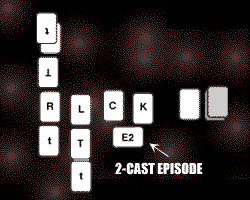 You have played a 2-cast episode card (E2) under Cat (C) and Kryten (K). Since Listy and Rimsey are already occupied with their tasks, they could not join in an episode. We moved Kryten beside Cat to make things easier; the boys of the Dwarf rarely stay in one place anyway! Both you and your opponent may now play travel cards to race to complete the episode.
figure 5
 Now your opponent causes some trouble (dt)... he plays it as you play a travel card (pinkish t) on Cat's task. Since you did not counter his evil play, all of your travel cards for Cat's task are discarded, and then your opponent discards his trouble card and draws a new card. If you had a Smeg Off card, you could have stopped this sad turn of events.
figure 6
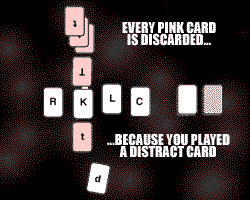 The distract card (d) wipes out all travels along with the mission. In this example, you have distracted Kryten, causing all of the pink cards to be discarded, since your opponent couldn't stop you. Then you discard your distract card and draw a new card.
|
| |
 Card Management Card Management
Instead of drawing from the laundry list to begin your turn, you may draw the top card of the garbage pod if it is not a Re-Cyc card. Only travels and tasks may be drawn in this matter. This is called "working zed shift."
When discarding groups of cards, always let the player whose turn it currently is decide in what order the cards are placed in the garbage pod, but always place any Re-Cyc cards on top. This prevents one player from stacking the garbage pod in his immediate favor.
Remember that you must always end your turn at exactly 7 cards in hand. If you played an episode or Holly this turn (cards that did not come from your hand), you will be forced to discard down to 7.
Cards drawn due to Re-Cyc cards cannot be immediately played as part of an ongoing chain of effects. I.E. if you play a smeg off in response to Hudzen 10, your opponent cannot use the smeg off he just drew because of playing the Hudzen 10 to counter your smeg off. He may only use a smeg off card that is already in his hand.
Remember that when episodes and/or Holly are sent to Silicon Heaven, they are not placed in the garbage pod but instead returned to the BBC.
When the laundry list runs out of cards, shuffle the garbage pod and make that the new laundry list. Cards in the players' stasis booths are not shuffled back into the laundry list.
|
|
| |
 Scoring Plot Points Scoring Plot Points
As soon as you play the final travel card needed for the mission, you score the mission by placing the mission card in your stasis booth. The travel cards are sent to Silicon Heaven; any cards placed in the garbage pod are placed in whatever order you choose.
As soon as your stasis booth contains 11 or more plot points (due to mission and bonus point cards), you have won the game.
If your opponent has any travel cards played on this mission, they are sent to Silicon Heaven along with yours.
You may attempt to complete any mission on the table, not just one you have played personally. (figure 7)
|
figure 7
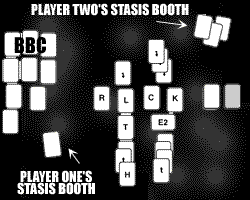 Smeg! Looks like player two is ahead, judging from the three scored cards in his stasis booth... must've completed Rimmer's task and picked up a bonus point or two. But you look to be in pretty good shape... you're closer to finishing that episode, and you've cornered Holly (H) on Lister's task.
|
| |
 Tips Tips
Keep track of Holly! Be wary of playing a mission that requires Holly; if you have no countermeasures your opponent can simply play Holly and prevent you from scoring the mission.
Use missions with more than one of a particular travel card to trap opponents. Wait until he plays that second Drive Room before playing a trouble card, to maximize his card loss.
Keep the game moving by using focus and distract cards to draw new cards.
Don't pin all your hopes on one mission, unless you are extremely confident in it. All it takes is one successful distract card and your entire strategy is lost.
Use the bonus point cards whenever possible. This is the quickest way to get plot points.
Become familiar with the card ratios and divisions. The more you know about the card mix, the better you'll be able to plan ahead.
Keep counting how close your opponent is to completing a mission. You can't play discard travels cards on that last needed card, so plan in advance.
|
figure 8
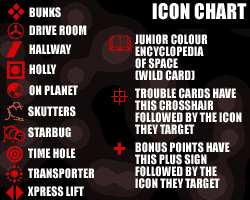
|
| |
 Glossary Glossary
BBC - the BBC is where cards are placed that both players have equal access to, like episodes and Holly
bonus point - bonus point cards are a kind of Re-Cyc card that allow the player to score an extra point if the card is played correctly. Bonus points that are played successfully are placed in the successful player's stasis booth. Whenever a bonus point card is played - regardless of whether or not the listed effect was successful or not - that player immediately draws a card from the laundry list to replace it
cast - the cast consists of Lister, Rimmer, Cat and Kryten
Cat - one of the cast, Cat is a member of felis sapiens, a race of evolved house cats. Most of Cat's tasks involve preening and prowling
discard travels - discard travels is another way to refer to trouble cards
distract - the distract card is a kind of instant effect that one player may play on any one cast member to cause him to become distracted from a mission
distracted - when a cast member is distracted from a mission, the mission card and all travel cards previously played on the mission from both players are sent to Silicon Heaven. Any cast that was on the same mission but were focused are immediately un-focused
episode - episode cards are a kind of mission requiring more than one cast. When episodes are sent to Silicon Heaven, they are not placed in the Garbage Pod, but are instead returned to the BBC. Episodes come in three types, involving 2, 3 or 4 cast members
focus - the focus card is a kind of instant effect that allows one player to cause a single cast member to become focused
focused - when a cast member is focused on a mission, he cannot be affected by a distract card
garbage pod - the garbage pod is the pile of discarded cards
Holly - the ship's computer, Holly tries to oversee all of the cast's activities. Holly is a special kind of travel card that all players have equal access to. When she is sent to Silicon Heaven, she is not placed in the garbage pod but instead returned to the BBC
instant effect - instant effect cards are a kind of Re-Cyc card that can be played by either player at any time. The three instant effect cards are Focus, Distract and Smeg Off. As soon as an instant effect is played, the effect listed on the card takes place. Immediately after playing an instant effect card - regardless of whether the listed effect was successful or not - he draws a card from the laundry list to replace it in his hand
laundry list - the laundry list is the draw pile
Lister - Lister is the last human being alive some three billion years in the future. Lister spends his time finding new and ingenious ways to waste it, and his only goal is returning to Earth, wherever and whatever it may be
Kryten - a series 4000 service mechanoid, Kryten does his best to keep the ship clean and the cast fed
mission - mission is the generic term for both episodes and tasks. Completing missions is the primary source for scoring plot points. When a mission card is completed, it is placed in the completing player's stasis booth , all travel cards are sent to Silicon Heaven and the cast member(s) that was on the mission is un-focused if he was focused. Mission cards contain ribbons of icons that correspond to different travel cards
plot points - plot points are collected by completing missions and scoring bonus points. The stasis booth is essentially a record of plot points scored. When a player scores 11 or more plot points, that player has won the game
Re-Cyc - Re-Cyc cards include trouble (discard travels), bonus points and instant effects. Whenever a Re-Cyc card is played - regardless of whether or not the listed effect was successful or not - that player immediately draws a card from the laundry list to replace it
Red Dwarf - a gigantic mining ship of the Jupiter Mining Corporation. This is where the cast spends 99.9 percent of their time
Rimmer - a hologrammatic representation of one of the long-dead crew members of Red Dwarf, Rimmer is weaselly, cowardly and supremely flawed
send to Silicon Heaven - any card that is removed from the playing area is sent to Silicon Heaven. Travels and tasks that are sent to Silicon Heaven are placed in the garbage pod. When Holly or an episode is sent to Silicon Heaven, the card is returned to the BBC. Technically, Re-Cyc cards are never actually on the playing field, so they are discarded to the garbage pod after being played without being considered to have been sent to Silicon Heaven
smeg off - smeg off is a type of instant effect card that allows one player to cancel the effects of any just-played Re-Cyc card. Whenever a smeg off card is played - regardless of whether or not the listed effect was successful or not - that player immediately draws a card from the laundry list to replace it
stasis booth - each player has his own stasis booth, a pile where all scored missions and bonus points are placed. When this pile contains 11 or more plot points, that player has won
task - task cards represent a one-cast mission. Each cast member has five tasks that only he may embark upon. There are four tasks that any of the cast my attempt. When a task is successfully completed, the card is placed is the completing player's stasis booth. If a cast member is distracted from a task, the task card is placed in the garbage pod
travel - travel cards represent objects and places that the cast use in completing missions. Each travel card has its icon in the upper right corner. These icons correspond with smaller icons found on all mission cards
trouble - trouble (discard travels) cards are a subdivision of Re-Cyc cards that one player may play to force his opponent to discard all of his previously played travel cards for a particular mission. Whenever a trouble card is played - regardless of whether or not the listed effect was successful or not - that player immediately draws a card from the laundry list to replace it
un-focused - normally, all cast members are thought to be un-focused, until a focus card is played. A cast member can only become un-focused when his mission is completed or when his partner on an episode is distracted
zed shift - the act of drawing from the garbage pod instead of the laundry list. Only travels and tasks may be drawn in this manner
 Thanks Thanks
Special smegs to playtesters and commentators Marci Fourhman, Chris Benson, Mike Fell, Rhonda Millin, Ken & Lisa Huth, Jason Bertovich.
Huge smeg to Rob Grant and Doug Naylor (and the BBC) for creating such a fantastic and enduring television show.
Extra smegs to Chris Barrie, Craig Charles, Danny John-Jules, Robert Llewellyn, Hattie Hayridge, Norman Lovett, Chloe Annette, C.P. Grogan and the rest of the cast and crew of the show for bringing Grant Naylor's creation to life.
Revision History
draft 1.5 (November 2000) Card set updated to version 2. This caused some major changes to the cards themselves, but only minor changes to the rules.
draft 1.3 (June 1998) "Discard Travels" changed to "Trouble."
draft 1.1 (March 1998) Minor clarifications; graphics added to rulebook.
draft 1.0 (May 1996)
|
|

